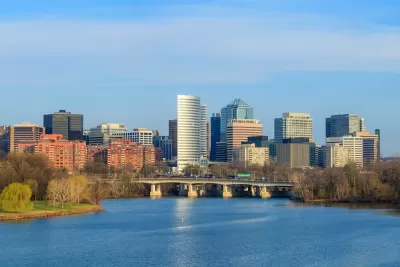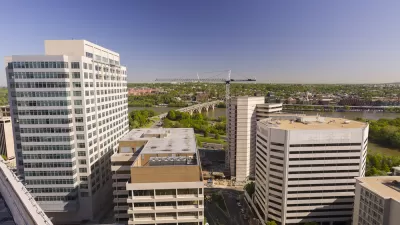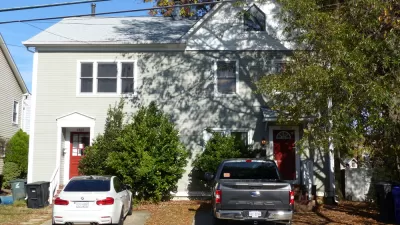The successes of Arlington, Virginia as a suburb have been discussed by planners and urbanists before, but the model has taken on new meaning as the current urban boom send ripple effect out into nearby suburbs like Long Island and Palo Alto.

An article by Henry Grabar details the success of Arlington, Virginia in implementing the benefits of urban life, while also limiting some of its negative impacts: "Despite the influx of tens of thousands of workers and residents, despite the transformation of this sleepy suburb into a mid-size city, traffic has thinned."
"In essence, Arlington has shown that the mistakes of American suburban development can be corrected within a few decades." And how'd it do that? "[Without] citizens’ willingness to support high-density zones, Arlington would still look much as it did in the Kennedy administration."
Here's how Grabar describes some of the planning choices that lead to Arlington's success. "Around the new Metro stops, the county devised a series of “bull’s-eye” plans for high-density, mixed-use developments. Between 1970 and 2000, the Rosslyn-Ballston corridor— just two square miles — added 15 million square feet of office space and 15,000 residential units. Adding in the Metro corridor in nearby Crystal City, Arlington’s seven “station sectors” produce half of the county’s real estate revenue from just 7 percent of its area. It may be the only American suburban district where fewer than half of residents drive to work."
Among the background reportage driving Grabar's Salon story comes from an article by Canaan Merchant for Greater Greater Washington, which details the statistics behind Arlington's reduction of vehicle traffic and its increased use of transit (compared to Grabar, who builds the narrative of how Arlington got to its unique position). Summing up how Arlington achieved the results detailed in the post, however, Merchant says, "Arlington has embraced transit-oriented development and walkability for a long time, but in the 1970s and '80s when the county was originally debating its plans, some of Arlington's choices seemed like risky moves."
Grabar's larger, political point, is pointed toward the NIMBY culture of the suburbs surrounding cities like San Francisco and New York City: "But without a doubt, there’s one lesson whose import will resonate with suburbanites from Huntington to Palo Alto: No suburb can urbanize without the support of its residents."
FULL STORY: The suburb of the future is here

Planetizen Federal Action Tracker
A weekly monitor of how Trump’s orders and actions are impacting planners and planning in America.

Map: Where Senate Republicans Want to Sell Your Public Lands
For public land advocates, the Senate Republicans’ proposal to sell millions of acres of public land in the West is “the biggest fight of their careers.”

Restaurant Patios Were a Pandemic Win — Why Were They so Hard to Keep?
Social distancing requirements and changes in travel patterns prompted cities to pilot new uses for street and sidewalk space. Then it got complicated.

Platform Pilsner: Vancouver Transit Agency Releases... a Beer?
TransLink will receive a portion of every sale of the four-pack.

Toronto Weighs Cheaper Transit, Parking Hikes for Major Events
Special event rates would take effect during large festivals, sports games and concerts to ‘discourage driving, manage congestion and free up space for transit.”

Berlin to Consider Car-Free Zone Larger Than Manhattan
The area bound by the 22-mile Ringbahn would still allow 12 uses of a private automobile per year per person, and several other exemptions.
Urban Design for Planners 1: Software Tools
This six-course series explores essential urban design concepts using open source software and equips planners with the tools they need to participate fully in the urban design process.
Planning for Universal Design
Learn the tools for implementing Universal Design in planning regulations.
Heyer Gruel & Associates PA
JM Goldson LLC
Custer County Colorado
City of Camden Redevelopment Agency
City of Astoria
Transportation Research & Education Center (TREC) at Portland State University
Camden Redevelopment Agency
City of Claremont
Municipality of Princeton (NJ)





























